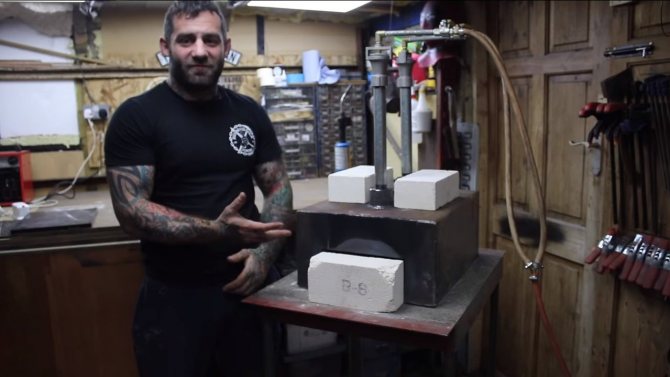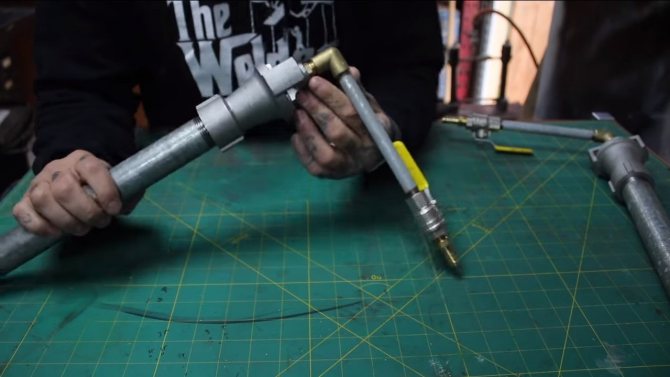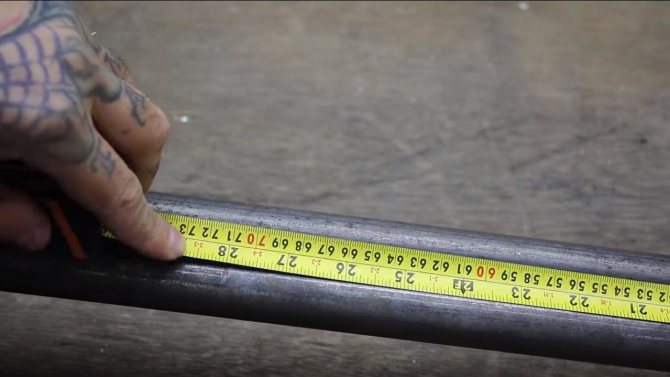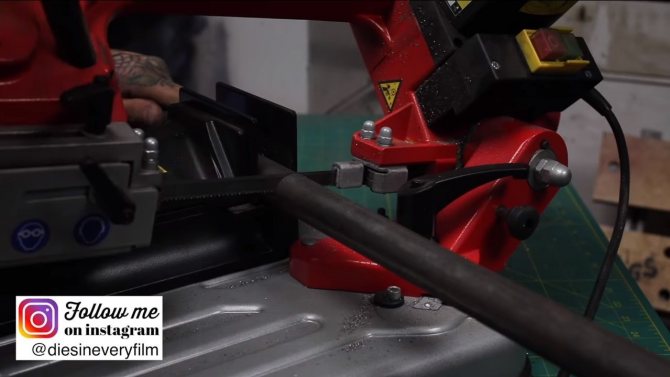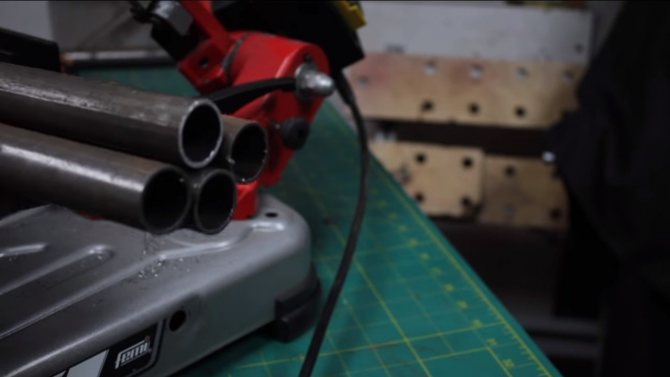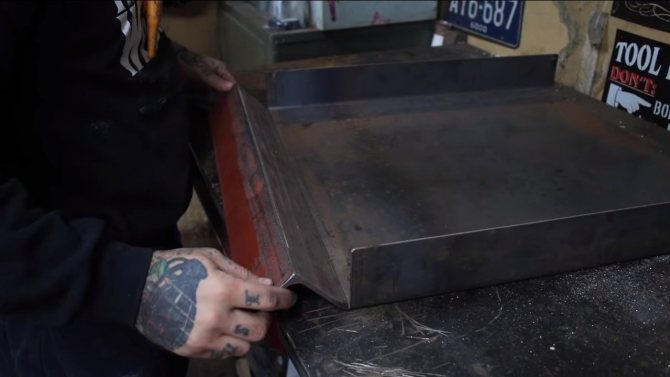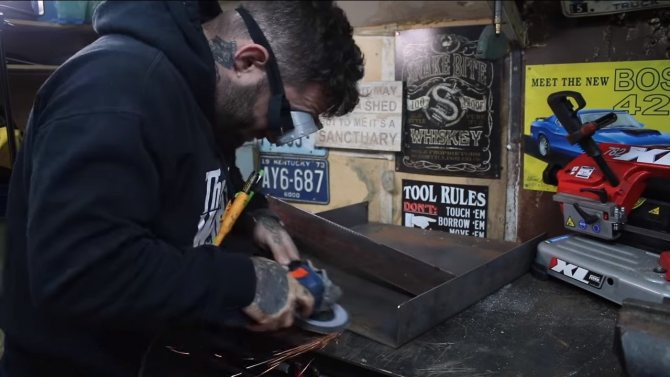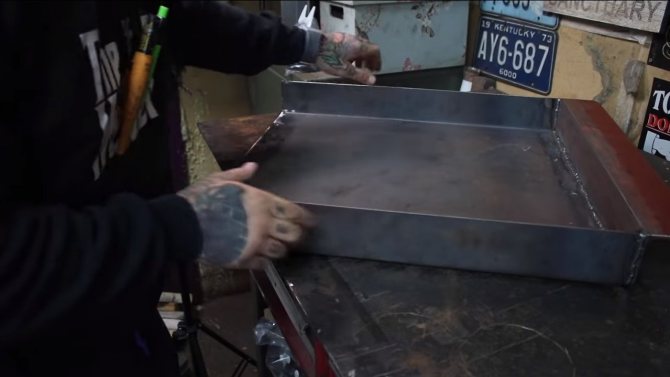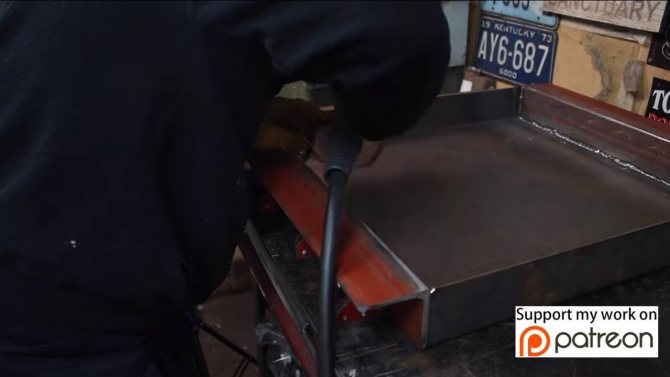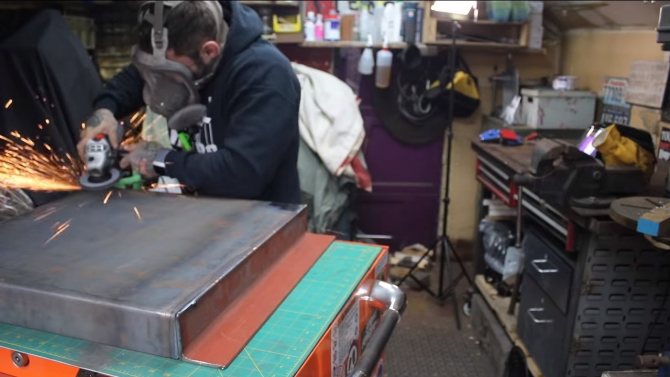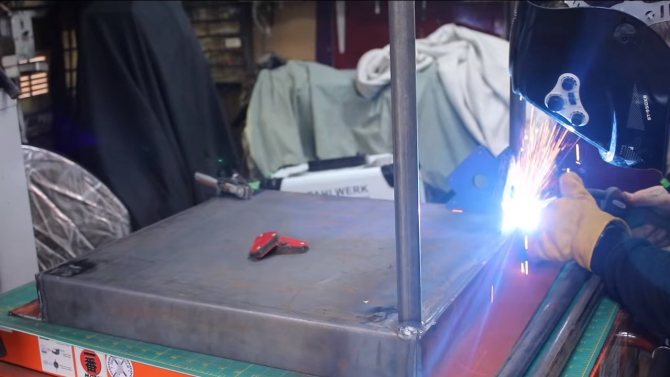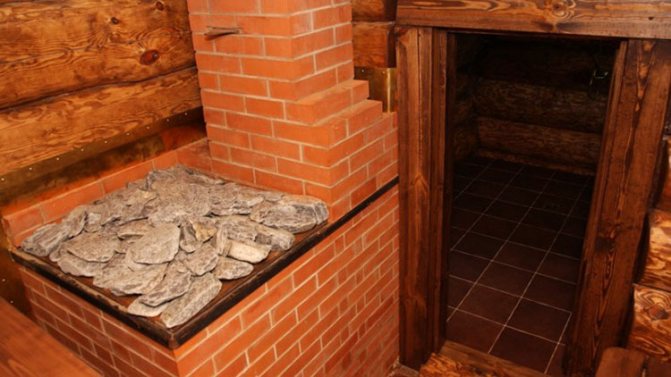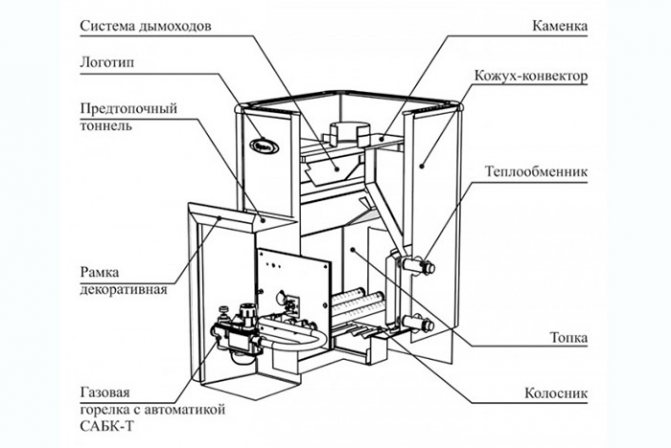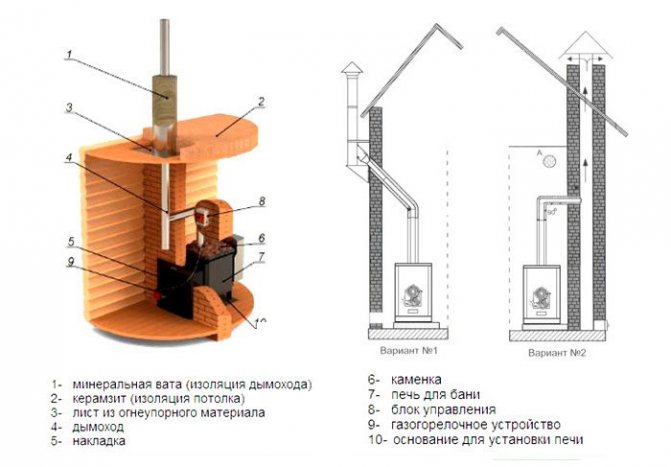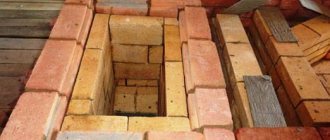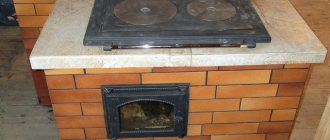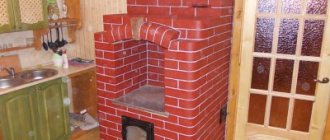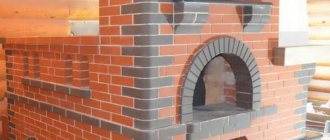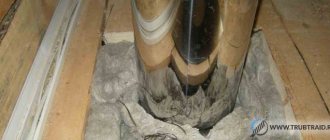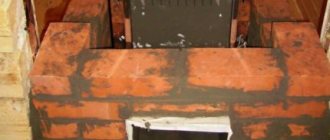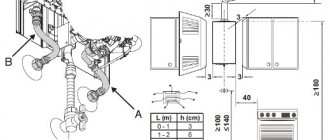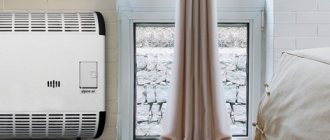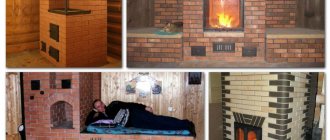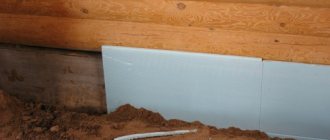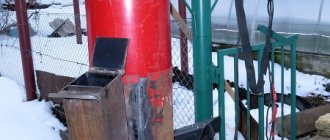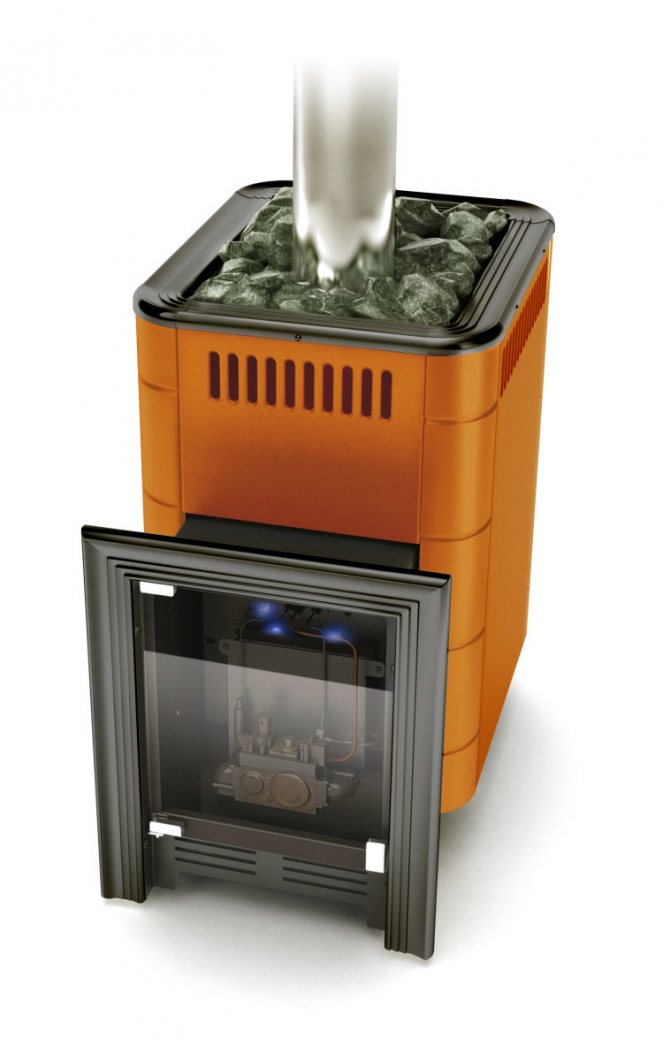
Every year, gas-fired stoves are increasingly used in the construction of baths. These devices largely prevail over wood-fired units. They are easy to use and quickly heat up the room. In just three hours in summer and eight hours in winter, the steam room air is heated to the optimum temperature required for bathing procedures.
The gas stove is easy to operate: by setting a certain combustion mode, you can quickly heat up a spacious steam room without worrying about the regular laying of firewood.
Before equipping a new bath with a modern gas oven, you need to familiarize yourself with the following factors, on the basis of which the unit is selected:
- types of devices;
- design features;
- performance characteristics;
- advantages and disadvantages;
- installation conditions.
Types of devices
The range of gas stoves offered for installation in baths and saunas is quite wide. All units differ in material of manufacture, methods of heating water and types of burners.
Usually, baths are equipped with either impressive-sized stoves made of brick or stone, or more compact devices, the body of which consists entirely of metal. The first types of ovens retain heat for a long time, but they take some time to heat up. The units made of metal, although they cool down quickly, do not heat up for so long. In addition to compactness, these ovens are also distinguished by ease of installation and operation.
If you use a brick or the same stone when facing such an aggregate, you cannot immediately distinguish it from structures originally made of these materials.
How to brick a metal stove, we considered earlier.
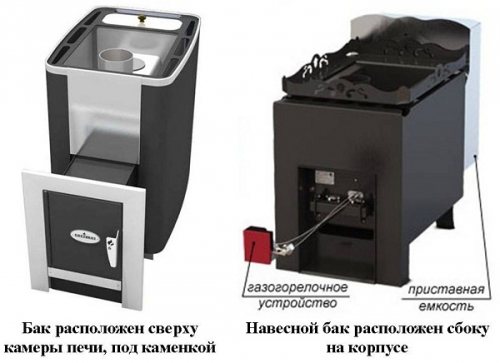

Separately installed and built-in tanks are used to heat water in gas-fired units. Remote tanks are connected to the heating device by means of pipes and are usually located near the furnace or through the wall in an adjacent room. Water, heated in the firebox, is drained into such a tank. A gas-fired sauna stove must be equipped with a heat exchanger.
The version of the container built into the furnace unit is convenient first of all because it does not clutter up the bath space. The water in it is heated by the combustion of fuel and is kept warm by the high temperature emanating from the red-hot stove. In this case, the container for heating the liquid must surround the smoke channel of the device.
An important element in the design of sauna stoves are gas burners, which are available in two varieties: atmospheric and pressurized.
The first type of device is considered the simplest, not burdened by the serious subtleties of automation. Air enters them through the ash pan door or through special air ducts. As far as the quality of oxygen supply is carried out, the furnace equipped with an atmospheric burner works as efficiently. For the complete combustion of fuel, the rate of oxygen supply to the furnace is important. With a small inflow of air masses, the gas is partially burnt, which leads to a decrease in the efficiency, an important indicator of the operation of the furnace.
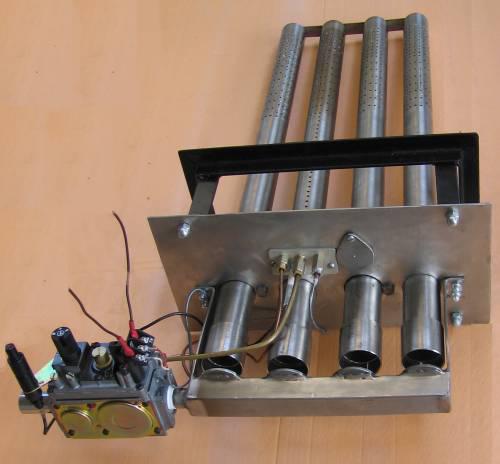

The complexity of the design and dependence on the energy source distinguish pressurized burners. In order for the air to enter the combustion chamber in sufficient quantity, it will be necessary to install a special fan. Such a device can function normally only when the furnace and the smoke channel are completely sealed.Therefore, pressurized burners are completely unsuitable for brick units, because good air permeability belongs to the properties of the material from which the device is laid.
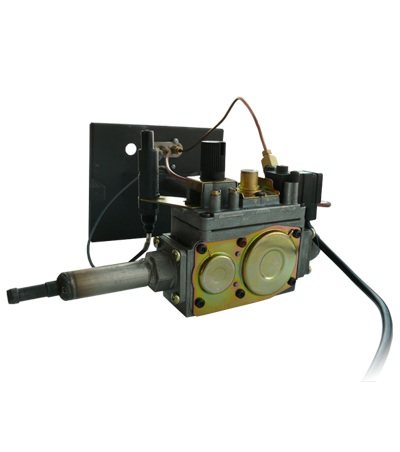

The design of such burners is more efficient than their atmospheric counterparts. Built-in turbocharged devices allow the use of such devices in a combined mode, which is not at all acceptable for atmospheric burners.
Brick and stone ovens
These designs differ in the duration of warm-up. If there is a desire to take a steam bath during the day, then you will have to start heating the bath at night or early in the morning. Of course, such a stove cools down much longer, for example, a well-heated bath, even in winter, retains heat for 2 days if there is a brick structure in it.
Brick structures must be installed on the foundation, since they have a decent specific gravity, differ little from the classic version of sauna stoves. The only difference is that the door will not open access to the firebox, but to the heater, which is located in the stove itself.
It is worth noting that the cost of a brick oven will be quite expensive, since a lot of material is needed for its installation.
As for metal gas stoves, they are much more popular with ordinary people, their advantages:
- Easy to install.
- The ability to build on your own, without the help of a professional bricklayer.
- The design has a low specific weight.
- It heats up quickly, thus it takes much less time to heat the room.
- Profitability, especially if you assemble the structure yourself.
Sauna stoves are divided into types according to the type of fuel:
- exclusively on gas;
- combined.
If everything is clear with the former, then the latter should be considered in more detail, since they are heated both on gas and wood. This versatility has significant drawbacks:
- bulkiness of the structure;
- it is imperative to install a blower burner;
- the complexity of execution;
- dependence on electricity;
- traditional wood stoves are much safer.
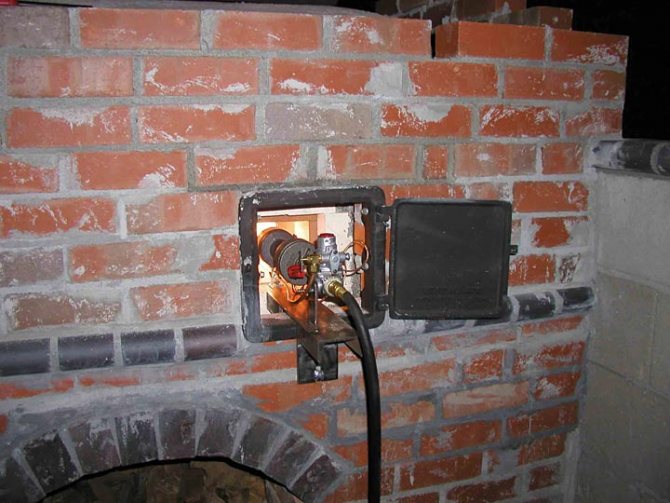

As for gas stoves, they can be equipped without having a gas pipeline nearby, since they perfectly function on propane, which is freely available and is sold in metal cylinders.
In addition, propane compares favorably with natural gas, the thermal energy during its combustion is much more efficient. This gas is economical when heating a small room in a bathhouse; you often don't have to fill up the cylinders.
But there is also a significant disadvantage - the need to equip a special room for the installation of gas cylinders, which should be at a sufficient distance from the building, outside of it. It is advisable to prepare a steel container dug into the ground.
Unit design features
In general, the design of a gas stove for a bath is similar to a wood-burning one, but the differences are manifested in the properties of the fuel. In the unit operating on liquid fuel, in addition to the body and the chimney, there is also a thermostat and a fuse that is triggered to turn off the fuel supply when the fire is extinguished.
Performance characteristics
Unlike a unit, for which firewood is manually laid in the firebox, fuel is supplied automatically through pipelines from the main gas line or when connected to tanks with liquefied propane. Autonomous gas supply is carried out by means of gas-cylinder installations, which should be located outside the bath, adhering to a certain distance in accordance with fire safety rules. Storage of cylinders in a special tank is also allowed. Propane, which is filled with such installations, is considered the most efficient fuel for the operation of the furnace.
Practice has proven that due to the use of one cylinder with a capacity of 5 cubic meters. m during the heating season, warmth is maintained in a room with an area of up to 200 sq. m.
Both natural and liquefied gas are supplied to the stove through a pipe. Some of the oxygen required to support the combustion process is fed into the combustion chamber along with propane. After all, it is known that the natural gas supplied to consumers already contains a certain part of the air. To provide additional thrust, the oxygen supply is regulated through a door located at the bottom of the front of the unit. This opening also makes it possible to periodically clean the burner from soot and carbon deposits.
Advantages and disadvantages
Despite such disadvantages as the obligation to connect to a centralized gas supply and the importance of equipping a gas cylinder station, such a sauna stove has many advantages. We will try not to miss anything and note here the main advantages of such a device:
- Compactness the design is due to the absence of an ash pan and a furnace of significant dimensions, required for laying firewood. The small dimensions of the gas stove make it desirable for steam rooms of any area.
- Profitability the device is due to the availability of the fuel used. It is cheaper to maintain a gasified bath than one that is heated by electricity or a large amount of firewood.
- Easy care and a minimum of attention is required from the owner of the gas oven. After fuel combustion, neither ash nor semi-rotten embers remain in them. The chimney and firebox do not require frequent cleaning, since they do not have significant blockages.
- Convenient adjustment the optimal temperature, set in the required mode, helps to maintain a healthy microclimate. Having warmed up the stove once, there is no need to worry about throwing firewood into the firebox, you can just enjoy bath procedures and communication with friends.
- Duration of service life manufacturers define a gas oven for twenty-five years. At the same time, it is assumed that if you constantly monitor the operation of the device and sometimes carry out preventive maintenance, you can significantly extend the period of operation of the device.

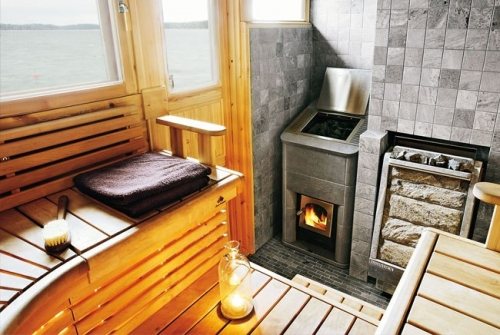
Baths, saunas and pools
48 votes
+
Voice for!
—
Against!
Natural gas can be called the most inexpensive fuel. And thanks to this economy, gas ovens are becoming more and more popular, including when used in baths. Gas powered devices are very compact and easy to maintain. Today we will look at how to make a gas oven for a bath with our own hands and what is needed for this.
- Preparatory work
Features of gas ovens
Today, a gas stove can seriously compete with a wood stove. It is much cleaner, easier and cheaper to use. She can warm up the steamy air quite quickly: in the summer in three to four hours, and in the winter a little longer. It takes about eight hours for the bath to warm up well. But high-quality heating provides comfort, warmth and coziness.
One of the main advantages of a gas bath, as we have already said, is economy. This fuel is the cheapest and most economical, so you can save a good amount. Wood and electric stoves will cost three times more! The gas oven does not require special attention to you. Combustible waste is very small, so the heating box and chimney ducts are practically not contaminated.
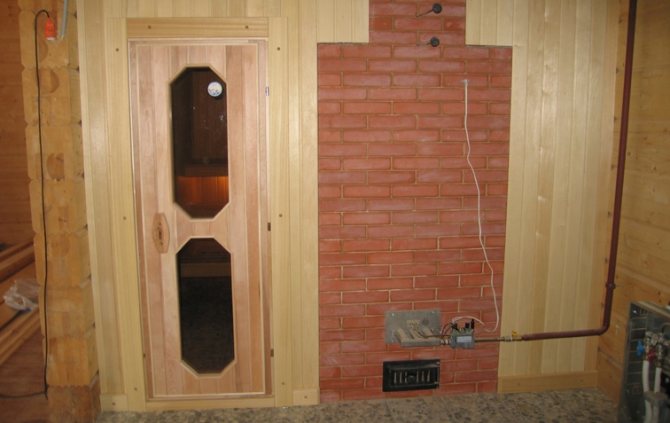

There are rules for installing a gas boiler in a bath, which are very strict, but they ensure high safety of use.The service life is approximately twenty-five years, and if you regularly carry out preventive maintenance, the oven will work for a long time and will not break down. If you do not take into account the overly strict safety rules, the disadvantages include only the mandatory presence of a centralized gas pipeline.
Gas furnace design
The device of gas stoves is similar to wood-burning ones, but it has some differences in fuel properties. The gas stove has a body, a fuse (to stop the fuel supply in case of damping), a thermostat, a sealed gas chamber, and a chimney. The difference lies in the fact that the fuel supply is carried out through the laid gas main.
Gas cylinders are placed in a special container in accordance with all safety regulations. As practice shows, a five-cubic meter gas canister can heat a room up to two hundred square meters during one heating season. It is worth noting that propane has a higher heat supply capacity when compared to natural gas. Such stoves can have different power, the calculation of which depends on the volume of the bath.
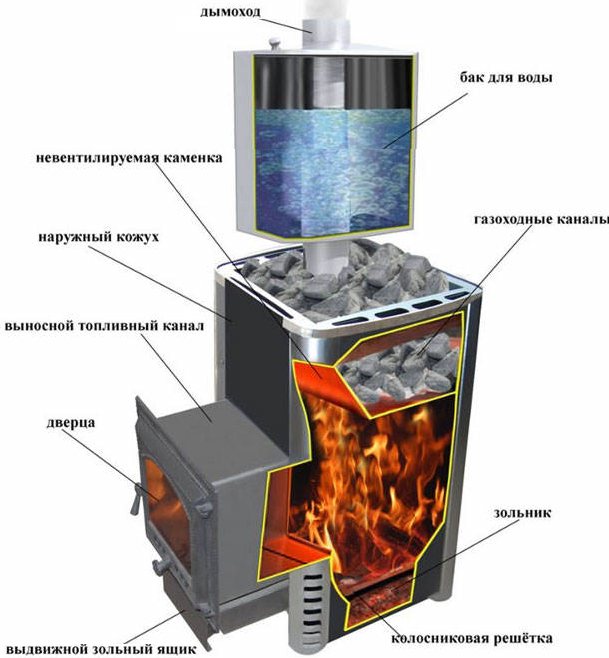

You should know that there are 252 kilocalories of heat per 0.4 cubic meters. Therefore, you can easily calculate how much gas you need. Gas bath stoves do not require periodic heating, so they should be turned off during use. Such furnaces work according to a very simple principle - air is mixed with gas even before it enters the firebox. A separate part of the air flows into the firebox.
You can adjust the amount of air supplied to the gas sauna oven using the lower door, which also allows you to clean the burner. Using a special flexible hose, gas is supplied to the burner (or a cylinder is used).
Classification of gas ovens
There are many different modifications of the gas oven. You must determine for yourself what kind of bath you want and, based on this, make a decision. The best option is a brick oven with an inflatable burner. A simpler option is a brick-faced metal stove. Gas boilers are divided by purpose - they can be heating, heating and domestic. As a rule, heating furnaces are used in baths, which differ in material, water heating technology and type of burner.
Materials for a gas bath stove
Homemade gas stoves for baths can be built from stone, metal or brick. Stone and brick take longer to melt than metal, but they also keep warm for a long time. But metal gas ovens heat up very quickly, but also cool down quickly. It should be noted that metal ovens are the most compact ones. They are very easy to install and use. If a metal stove is faced with a brick, it will not look different from a brick one.
Gas-burners
There are two types of gas burners: atmospheric and inflatable. Atmospheric burners are the simplest and cheapest. Their work does not require an automation system and sophisticated equipment. Gas combustion is supported by air, which enters the combustion chamber through the blower or ash pan door. The efficiency of the work depends on the amount of air inside the bath, so a small amount of oxygen can lead to problems. There are also inflatable burners, but such equipment is more complex.
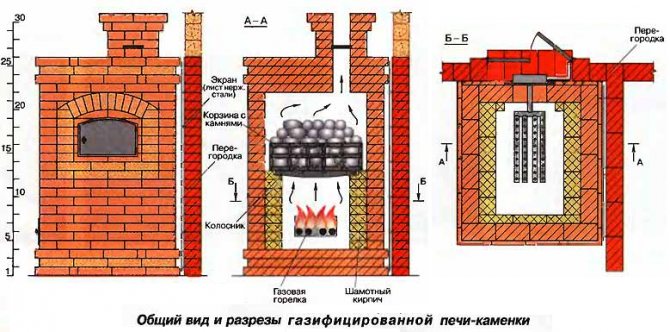

The design of such burners depends on a fan that blows air from the outside and depends on the electric current. The price of gas stoves for a bath with inflatable burners will eventually turn out to be the highest, since this option is more expensive in terms of electricity consumption, but also more efficient. It is often used in so-called combined stoves, which can be fired not only with gas, but also with other fuels, for example, wood.
Water heating methods
There are gas ovens with an already built-in water tank and a remote version. The first option is more convenient, since the water is heated by the combustion products of the fuel. The chimney must be installed so that it can pass through the heated volume of water. Heating the tank also generates heat, which comes from the heater. This option allows you not to clutter up the bath with unnecessary appliances.
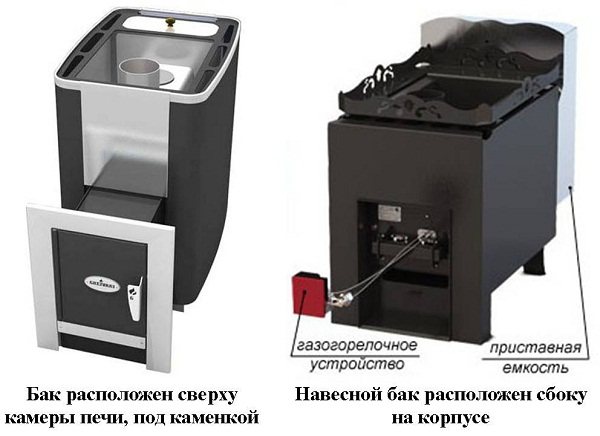

As for a gas oven with a portable tank, it is usually located on a nearby wall or in another room. The two elements are connected by a system of pipes through which hot water flows, which heats up inside the furnace.
Do-it-yourself gas stove for baths
Please note that a permit is required to install a gas oven in a bath. A brick oven can create the best combination of humidity and temperature. It may seem that such an option is very difficult to establish, but with diligence and adherence to all construction technologies, any good owner can cope with this task.
Preparatory work
First you need to design everything and choose the most suitable place. As a rule, the stove is placed near a partition or wall, since it must heat the steam room and maintain the optimal temperature in the rest room. The main elements of a home-made gas oven: base, chimney (insulated with mineral wool), heater, burner, sheet of fire-resistant material, pad, control unit.
When creating a stove, you can use the leftover materials that were not needed during the construction of the bath, but it is better to buy new ones. We recommend that you do not skimp on quality, because a good oven will provide you with its reliability and durability. In the process of work, you will need the following materials and products: red fired brick, clay, galvanized sheet metal, reinforcing bar, metal pipe, grate, sand, blower doors, asbestos-cement pipe, firebox doors, water and gas pipe and steel sheet.
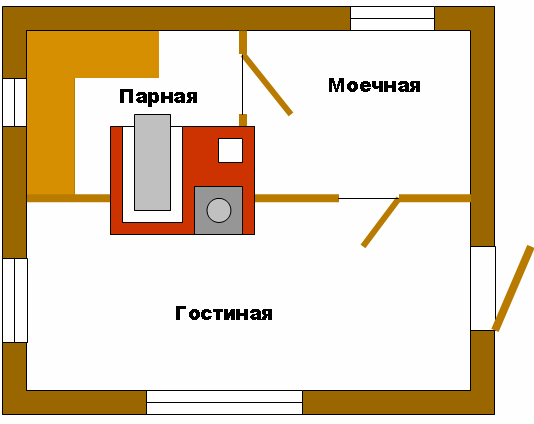

Before you make a gas stove for a bath, you need to build a foundation. Its construction begins with a pit, the bottom of which should be located below the freezing of the ground, which takes about seventy centimeters. At the very bottom, its width should be slightly larger than the main notch. This technique will help to avoid unnecessary trouble in case of ground movements. The bottom of the pit must be covered with sand fifteen centimeters thick. The sand is filled with water, soaked and covered with a stone with broken bricks about twenty centimeters deep.
After that, crushed stone is applied, formwork is made and a reinforced frame is installed. Next, it is necessary to pour concrete, after setting which the formwork is disassembled, and the surface is covered with tar in several layers. The place that has been freed from the boards can be covered with fine gravel with coarse sand. Be sure to install a moisture barrier on the top of the foundation.
Furnace wall arrangement
After arranging the foundation, you can start installing the walls. To begin with, a protective wall is made, which can protect the bath from possible ignition. It is made of cut bricks, which are held together with cement mortar. For a brick bath, it is better to use a sand-clay mortar. As a rule, clay is taken at a depth of at least half a meter of the earth.
It is poured with water in a special container for a day and mixed thoroughly. The sand must be cleaned of debris and sieved. After that, sand and clay are mixed in a 1: 1 ratio, then mixed again with the addition of water. When the solution takes on an absolutely even consistency without lumps, you can begin construction. It is better to prepare the solution in small batches, as it is consumed.
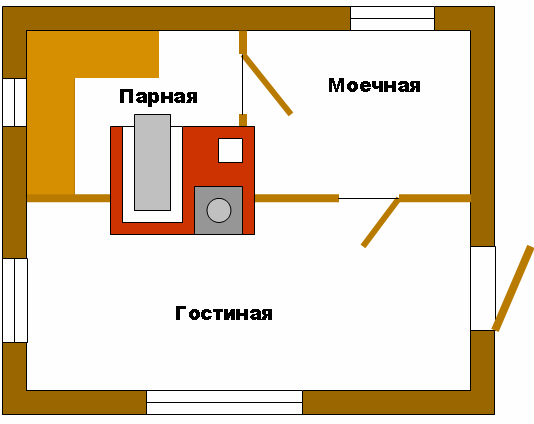

The very first brickwork plays a very important role.A waterproofing gasket made of bitumen is preliminarily placed on the foundation, on which the first layer is placed. All bricks are wetted with water, ideally place the brick in water and wait about ten minutes. When the brick is laid on the mortar, it should be held back a little with a construction pickaxe.
Check carefully that the bricks fit snugly together and that the seams are no thicker than five millimeters. The second and next rows are laid in such a way that each brick subsequently overlaps the joint of 2 bricks of the lower row. Before laying bricks in mortar, builders recommend laying them dry so you can see the full picture.
Each stage of construction must be coordinated with the drawings of a gas oven for a bath. During the laying of the third row, it is necessary to build in a blower door, which is secured with galvanized wire or cut strips of steel sheet. In the fourth row there is a well for ash and grate. For its reliable placement, it is necessary to make grooves and leave room for its expansion (one centimeter is enough).
Fittings installation
The sixth row should complete the installation of the blower door, and the seventh should complete the placement of the grate and the firebox door. The most durable are cast-iron doors. In the eighth row, a partition is mounted - the beginning of the chimney. Bricks are stacked up to the fourteenth row, on which the channels are placed.
Make an opening in the front wall for a container in which water will be heated and which is installed on the channels. The sidewalls hold the container vertically. The fifteenth row is laid from halves of bricks and placed at an angle. The halves will be the basis for laying the dividing wall. In the same way, the next three rows are laid, as well as the first.
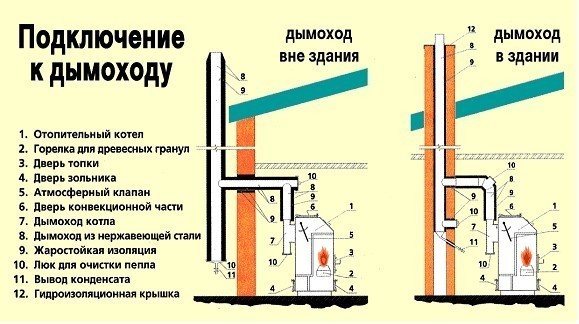

At the nineteenth row, you can install a steam outlet. Thin mild steel strips are placed between the twentieth and twenty-first rows, after which a hot water container is placed, which is surrounded by fragments of bricks. A chimney is installed from the twenty-third row, which is selected based on the modification of the furnace. The pipe above the roof must rise at a distance of at least half a meter.
A massive gas boiler for a bath should have a large and heavy pipe, and a small one - light. Remember that the pipe must be at least half a brick thick. The smoke passage must be of the same dimensions. Here it is better to use a solution of lime or cement. The clay composition can wash away the rain, leading to destruction.
Final work
After completing all work, the oven must be plastered. This procedure will improve the appearance and serve as additional protection against fire. Plaster can be made from any solution by adding alabaster to it. You can use plaster as well, but keep in mind that it hardens very quickly. An excellent option for plastering is clay, gypsum and sand mixed together (gypsum can be excluded).
Before plastering, it is necessary to prepare the wall of the stove. It is cleaned from the frozen solution to one centimeter. After that, it is better to putty. If you are going to heat the bath with liquefied gas, the cylinder should be placed outside. Many bath owners bury gas cylinders a few meters from their location. Let us remind you that liquefied gas has a higher heating value.
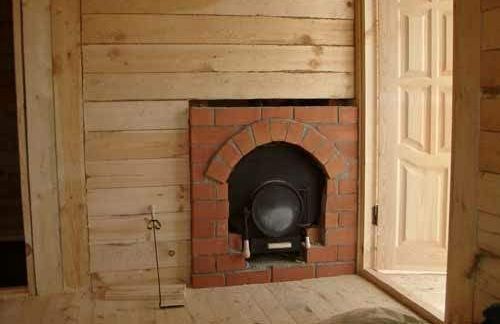

If you are assembling a gas boiler for a bath with your own hands, it is better to give preference to the SABK-8-50S automation system. This system perfectly maintains the set temperature and is familiar to all craftsmen. It is also as safe as possible - due to four levels of automatic protection.
This automation tends to turn off the heating equipment in emergency situations: when the flame goes out, if the gas pressure drops below the set point, or if the impulse automation system is depressurized. Such an oven is erected from eight to ten days and dried within two weeks. After that, you can start to melt it gradually, but you should not immediately bring it to a strong warming up.
Security questions
To correctly make a stove for a bath, you should study the instructions for a gas oven for a bath and strictly follow them.As you know, a gas boiler is an explosive structure. To reduce the risk of fire, it is recommended to adhere to the following rules:
- The stove must be at least half a meter away from structures that can catch fire. This distance can be reduced by installing a protective barrier made of refractory material (eg iron). If the wall next to the stove is made of a fire hazardous material, a special screen should be installed opposite the door, which has a size of two furnace openings.
- When installing the stove and chimney, a stainless steel pipe must be used. Pipes must not be pulled through living quarters. The chimney must be up to five meters from the level of the burner. Do not forget to tightly connect the chimney to the stove.
- The burner opening must have the following dimensions: height from 470 to 550 millimeters, width from 350 to 450 millimeters.
- The chimney must be carefully insulated against heat loss. This is done where it goes through the roof and ceiling. The chimney is also insulated.
- The refractory base, which is located under the stove, should protrude one hundred millimeters from the edges of the appliance.
- The height of the room must be at least two hundred and twenty centimeters. It must be equipped with exhaust ventilation and a window with a vent. All doors should only open outward.
- The gas pipeline, according to the scheme of a gas oven for a bath, is made of copper or steel.
- Flexible joints must be solid, pressure and temperature resistant, labeled "gas" and have a diameter of ten millimeters.
- If a centralized gas supply is not foreseen, it is necessary to install the discharge of combustible products to the atmosphere.
- A metal sheet with a heat-insulating layer below is laid on the floor in front of the oven.
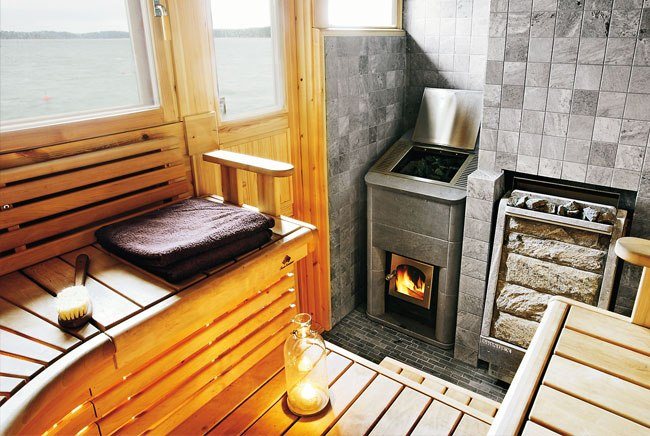

The gas stove is perfect for baths and saunas. Today this option is the most convenient and economical. If you decide to make a gas boiler for a bath with your own hands, you should take safety rules seriously and obtain permission from the relevant authorities. Subject to all construction technologies and the corresponding operating rules, your furnace will serve for a very long time and without interruption.
Range of gas ovens on the market
Today you can buy such equipment for a bath for any request. A Russian company from Novosibirsk that produces heating units under the brand name "Teplodar", has adequately declared itself in the domestic and foreign markets with high-quality certified products that meet international standards. The great popularity of gas stoves for a bath "Teplodar" is due to their ability to quickly heat up and high efficiency. Thanks to the special design of the stove, the steam room is evenly heated and filled with high-quality steam.
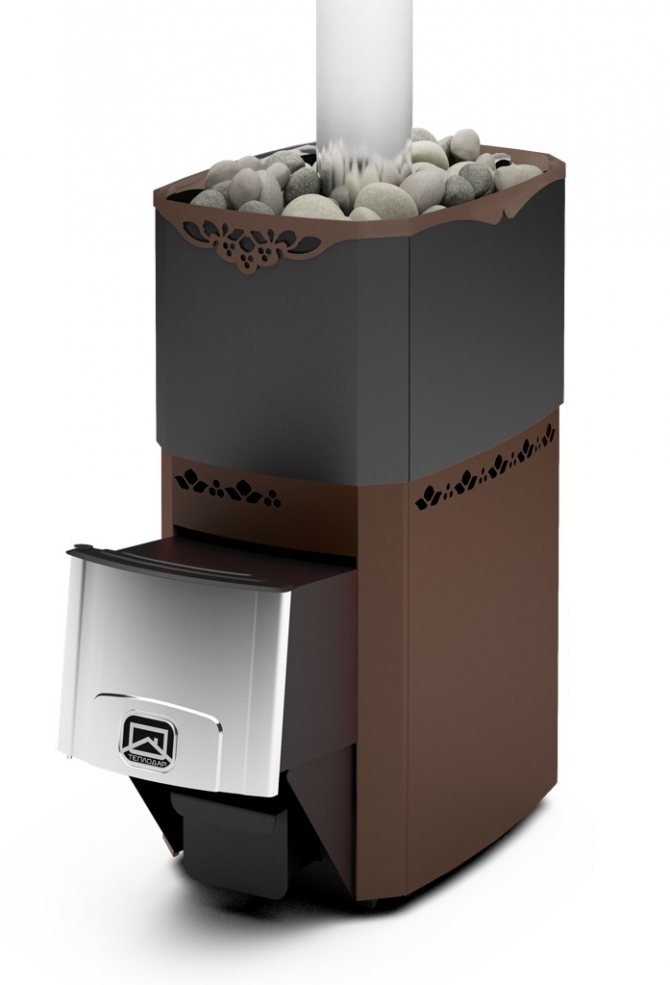

The popularity of gas units is also deserved. "Termofor", which are also installed in bath rooms. The first thing that attracts the consumer's attention to such products is their rather original appearance. In their reviews of the Termofor gas stove for a bath, numerous fans note the ease of use, high efficiency and excellent performance. Such a stove harmoniously fits into the interior of any bath, adding special comfort to the room and creating a warm atmosphere. All its internal technical units are hidden behind the translucent glass on the door of the device. The price of a gas oven for a bath "Termofor" fluctuates between 10-12 thousand rubles.
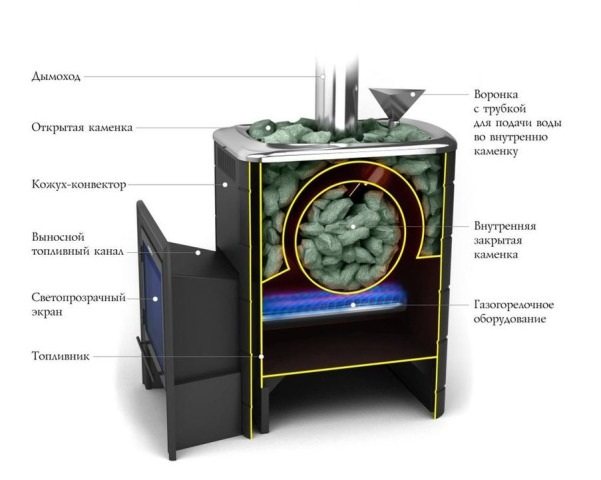

The main competition for the products of domestic companies is the German gas oven Kusatek... Such a device for heating baths has a lot of advantages. This is, first of all, compactness, simplifying installation, ease of use and quick heating, which ensures the achievement of the optimal temperature in a short time.Adjustment of operating modes is achieved by slightly turning the valve. There is no need to remove ash from the oven, since there is simply no ash. In addition, the inside of the device does not require regular cleaning.
German products are distinguished by a high degree of safety, which is why manufacturers confidently recommend installing such a stove in bath rooms. The risk of emergencies is also excluded due to the built-in control system, which is responsible for the quality of combustion and fuel pressure indicators.
Metal stove for a bath for gas or electricity
Anyone who loves to take a steam bath in informal communication admits that visiting a steam room or a bath is often negated by the need to tinker with loading fuel into the stove with his own hands, which reduces comfort. Do-it-yourself transition to more efficient ways of heating a bath, including gas and electric ovens, will give a lot of advantages:
- Cleanliness and order in the dressing room and steam room, which reduces the amount of work with your own hands;
- Accurate regulation of the degree of heating allows you to correct the shortcomings of the furnace made of metal or brick with your own hands;
- There is no alternative for an apartment bath; installing an electric stove with your own hands is the only safe option for equipping a steam room.
Advice! At the same time, it is not necessary to break or throw away the old sauna stove, it is easier and cheaper to remake it with your own hands for a new type of energy.
The simplest do-it-yourself calculation, as they say, "on the knee", will easily show that the use of electricity for an equivalent replacement of firewood or a briquette will cost more. For example, to operate a stove with a heat output of 10-15 kW, it will be necessary to burn about 2 kg of dry firewood per hour. When using a metal stove in a bath like Aito, with a small steam room of 12-15 m3, you will need at least 10 kg of firewood or 8 kg of briquettes for one visit. The cost of fuel, in order to heat the sauna room with a stove with your own hands, will be 50-70 rubles. In the case of using the stove on electricity, for the same duration of visiting the bath, you will need to wind up the electric meter by 45-50 kW / h, which will cost up to 200 rubles.
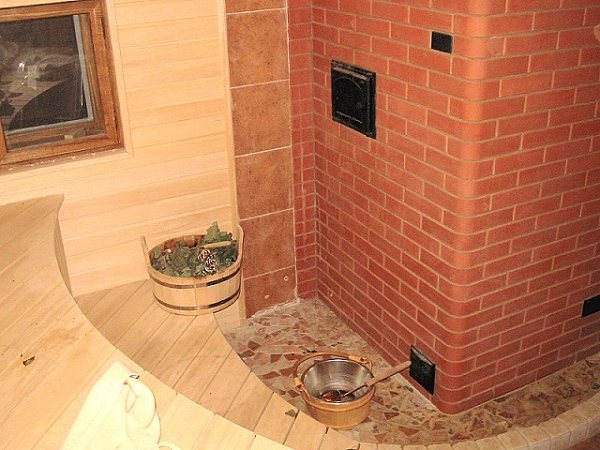

The use of gas fuel will allow you to reduce the cost of a sauna stove by an order of magnitude with your own hands.
Making a gas oven for a bath with your own hands
Before proceeding with the implementation of the plan for the manufacture of a homemade heating device, you should obtain permission from the relevant authorities to install such equipment.
Nevertheless, choosing from all the options, we suggest giving preference to a brick oven, which is distinguished by the ability to create an atmosphere in which humidity and high temperature are best combined. At first glance, this seems like a daunting task. However, with some effort and knowledge of building technologies, any self-taught master can handle the arrangement of a sauna stove.
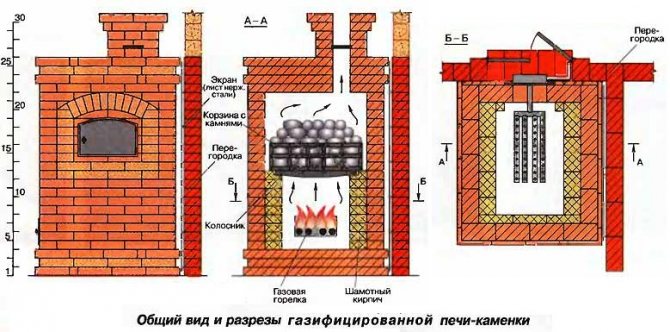

Preparatory stage
To build a gas unit for a sauna yourself, you need to decide on its location. Home baths usually consist of two areas: a steam room and a relaxation room. The stove is required to be able to fully heat the entire area and create the necessary atmosphere in the steam room. Often, heating devices are installed in a steam room near a wall that serves as a partition.
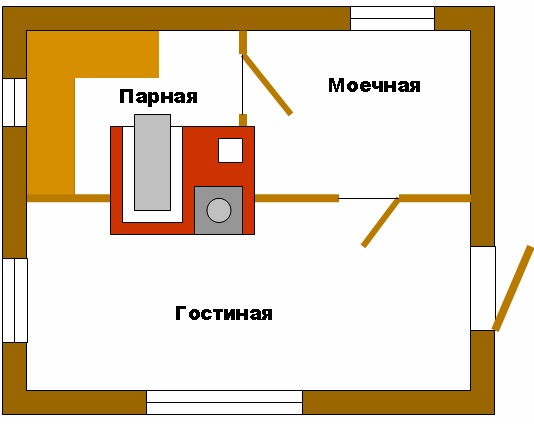

When constructing a gas oven for a bath, only high-quality materials should be used. In order for the construction process itself to go smoothly and without delays, you need to stock up on:
- for the construction of walls - with refractory bricks;
- to prepare the solution - with sand, clay and crushed stone;
- to strengthen the structure - with fittings and galvanized sheet;
- for the construction of a chimney - asbestos-cement and metal pipes;
- for arranging the stove - a grate and doors (furnace and blower);
- to ensure the flow of fuel and heating the liquid - water and gas pipes.
Lining
The dimensions of the furnace are multiples of the dimensions of the fireclay lightweight brick ШЛ-0.5, standard size No. 5. The dimensions of the brick are 230x113x65. In the photo it is white. Yellow ones are some other refractory brick with slightly different dimensions. But for my needs it doesn't matter. If necessary, I will do everything from SHL-0.5. Since lining the door with bricks is still something to do, so for the lining of the door I took a mat (blanket) Cerablanket of the Sukholozhsky plant. Refractoriness up to 1260 g. (In practice, withstands direct flame of a gas burner). Sold by the meter in rolls 610 mm wide, thickness from 13 to 50 mm. I would like to warn you against some ambushes that may lie in wait for you during the manufacture of lining. First of all, I want to warn against the temptation to use asbestos. Yes, it melts at 1500 degrees, but at 800 degrees it loses chemically bound water and turns into powder. Therefore, products made from it, such as cardboard or cord, can work up to this temperature.
Regarding the use of fibrous materials on a mineral (basalt) basis, I repeat what I wrote on one of the forums. They are almost the same thing. Produced by melt blowing. They keep the temperature well. But they have a binder that won't stand up to 250 degrees. But on the Internet, cunning sellers cite the refractoriness of the fiber itself. Formally, they are right. But the fact that after the first calcination the binder will burn out and they will crumble in a bunch, they do not write this. There are also varieties with a refractory binder, but there is very little information. Only indirect signs, for example, intended for baths and fireplaces. And again, the refractoriness of the fiber itself is carried out. So if there is a risk of flying over, it is better to use the already proven ones. And from those tested by me, mullite-silica felts are most suitable, for example, MKRVKh-250 (1300 gr) and this Cerablanket. Since we still had to use mats for the door, the vault was also made of it. If necessary, I will lay out everything with a brick SHL, since the dimensions of the chamber are already under it. The mats are attached to pins made of stainless steel electrodes. One end is sharpened, the other is welded with a stainless electrode to the furnace wall. As holders, pieces of sheet stainless steel with cross-cut slots.
Final stage of construction
The design of a gas stove for heating a bath is fully built in 7-10 days. After a two-week period, during which the mortar dries, you can already start a test kindling of the furnace, but you should not split it.
The plastering work completes the process of building the bath equipment. With the help of this finishing layer, the structure gains a neat finished look and additional fire protection. As a rule, alabaster is added to the mortar for facing the kiln, consisting of clay, sand and water.
Before finishing, the remaining mortar is removed from the walls of the furnace and a putty mixture is applied. As a result, we got the following oven:
When building heating equipment, it is recommended to use SABK-8-50S automation. With such a device, the required temperature will always be maintained in the bath. Such a device has four degrees of protection, which indicates its absolute safety. In the event of an emergency, thanks to this system, the operation of the furnace equipment is automatically stopped.
Burner selection
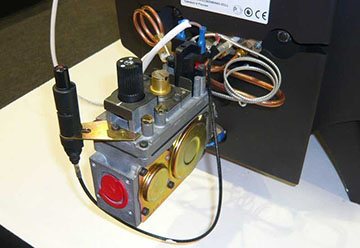

Burners are:
- Atmospheric.
- Inflatable.
For homemade construction, only pressurized burners can be used. They are more difficult than atmospheric ones, but much safer.
The devices are equipped with automatic valves that turn off the gas if the flame goes out, or the stove overheats, as well as if a leak occurs. There are models with auto-ignition.
You need to purchase a burner in advance, before stocking up on all materials. The fact is that burners come in various sizes and shapes - drawings and diagrams will be developed based on this.
Metal is a material that is easy to work with. A do-it-yourself sauna stove from metal can be made very quickly, besides, the design will turn out to be mobile.
For models of long-burning stoves for home, see this review.
Bath gasification
To ensure the full functioning of the constructed stove, it is necessary to take care of the gasification of the sauna. To do this, you should either purchase a cylinder installation, or bring propane from a centralized system.
It is possible to provide the bathhouse with an uninterrupted supply of fuel for many years by cutting into the main network passing through the site. However, to carry out such a laborious event, you will initially need permission from the appropriate authority. After that, you need to spend time and money on the following procedures:
- registration of a number of necessary papers;
- purchase of materials and equipment;
- invitation of specialists for installation of the unit;
- preparation of test and technical documentation and delivery of work to the gas service at the location of the site;
- cutting into the city-wide system;
- installation and registration of a gas meter;
- obtaining documents for payment for gas supply services.
Muffle production
In order to independently design a muffle furnace, first of all, it is worth making a refractory chamber. Not every material is suitable for these purposes. A special chamber can be made of fireclay bricks. It is perfect for both rectangular and cylindrical ovens. True, it is quite difficult to lay out bricks in the form of a cylinder. To do this, you need to cut out the same trapezoid with a grinder. For a small oven, you will need about 7 bricks.
After that, it is worth connecting them together with a wire, and also check that they fit tightly. Irregularities can also be corrected with a grinder. Next, you should lay out the bricks in a row and make several grooves for the wire, which in the future will be a heating element. It is important to make the grooves so that the wire does not touch anywhere. To do this, place slopes on one of the bricks. The grooves should be 7-8 millimeters wide, the distance between them should be at least 2 centimeters.
Heating system
In those territories where there is no possibility of gasification of the site, a cylinder installation with liquefied propane is often used to heat the bath. Vessels filled with liquid fuel are sold at specialized stations.
When purchasing gas tanks, you should remember about safety measures during installation. In no case should cylinders be installed in the bath room. They must be located in a ventilated and easily accessible area of the site, where there is also a fire extinguisher and a box filled with sand.
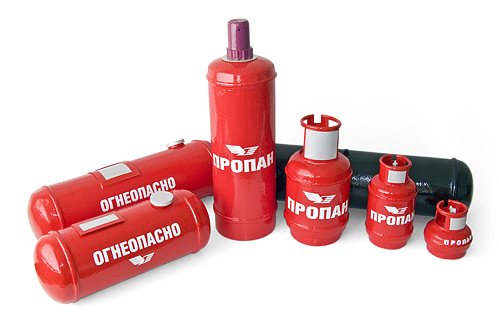

Features of assembly of a muffle furnace
The muffle furnace must be properly assembled in order for it to last for a long time. There are a few basic guidelines worth following:
- It is definitely worth strengthening the outer part of the structure with metal inserts, since the muffle chamber is quite heavy.
- The camera should fit snugly against the insulation of the main body.
- If you made the case yourself, you need to make the door from a double sheet of metal, and also be sure to place a layer of insulation on it.
- When using an old oven as a base, you can neglect the layer of insulation, since it is already provided for by the design of the oven.
- For the safe operation of the muffle furnace, it is necessary to connect the heating element to a 20-25 A machine.
A self-made muffle furnace is significantly inferior to industrial devices in terms of heating temperature.It is impossible to remelt metal in it, and it is also difficult to work with glass. But a self-made unit will be quite enough to fire a ceramic product at home. The main thing is not to neglect the installation of protective elements against voltage surges or gas leaks.

